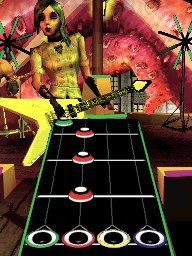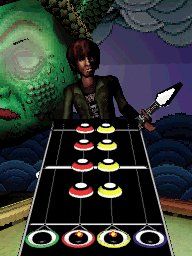
The DS is no ordinary handheld and Guitar Hero: On Tour is not the cash-in many observers had expected. Like its console big brother, it comes with a large and expensive peripheral that, once you get used to it, makes perfect sense. The guitar grip accessory is a chunky piece of plastic, about the size of a fist, that wraps around the back of the DS and plugs into the GBA slot on the bottom. Holding the DS sideways in book format (same as Brain Training and Hotel Dusk) you slip your hand through the padded strap and let your fingers rest on the four coloured buttons.
Yes, it looks nothing like a guitar and is not entirely comfortable to use at first, but after a short period of acclimatization it begins to make sense. It doesn’t add so much weight to the DS that it becomes a pain to hold, but it’s solid enough to justify the hefty asking price. Other DS accessories such as the slide controller from Mag Kid, the camera from Face Training and the paddle from Arkanoid haven’t been so expensive but we’d have to say the guitar grip is the most substantial of them all.
It also comes with a special stylus shaped like a pick, which slots onto the top when you’re not using it. Whip it out and you’re ready to rock, strumming the guitar strings on the touch screen. The touch screen takes the place of the strum bar in the console versions - you don’t actually hit the individual strings. Status displays such as your combo meter and star power indicator are also shown here. When you’ve got the knack of holding the four coloured buttons and swishing the stylus at the same time, Guitar Hero: On Tour plays very much like the console versions.
To play short notes you do a staccato flick on the screen in any direction. To play a longer note you move the stylus-pick on the screen and keep it pressed down for the duration. You can still do the up-down strumming favoured by expert players of the console games, although left-right might prove to be more a comfortable direction, depending on how flexible (or knackered) your wrists are. One of the chief differences is that in having only four buttons instead of the usual five, there’s a whole difficulty level missing. However, it’s better suited to handheld play without the screen-filling nightmare that is Insane mode - you’d have arthritic claws for fingers after half an hour of that on DS. The slight rebound on the strum bar of the console version of Guitar Hero 3 meant that players who prefer to play using a real pick (as you could in the first two versions) suffered double notes and mis-hits. On DS it’s controlled exclusively by pick, which means you can play at breakneck speed with relative ease.

Since the guitar grip’s strap and buttons effectively fix your fingers in place, there’s no sliding around the frets. If you found the full version a bit tricky, even with four buttons, you might have better luck with it on DS. Hitting a successful streak of notes will fill your star power bar, which you activate not by moving the neck of the guitar (there are no motion sensors in the guitar grip and, erm, it doesn’t really have a neck anyway) but by shouting into the microphone. This is one DS game you’re not going to want to play on the train. You can shout ‘star power’ or ‘rock out’ or just do your very best rock scream. Or you could blow into the mic and hope that sets it off. Either way, the effect is the same as in the console versions, and you’ll have a limited period of high-scoring mega notes to compensate for the potential shame of being seen yelling into your DS.
As you might expect for a music game on DS, a pair of headphones or a lead connected to your stereo will help you get the best out of the 30-odd tracks. We weren’t permitted to reveal the full track listing, possibly because there are licensing issues still to be resolved before the game’s summer release, but we can confirm that it’s not the same as the set featured in Guitar Hero 3. Instead, it’s a ‘best of’ compilation culled from all previous Guitar Hero titles, with a smattering of DS exclusives. Songs with slightly sweary or suggestive lyrics haven’t made the cut - certain raucous rockers have ensured the console versions are usually rated T (for teenagers) in the US or a BBFC 12 certificate in the UK, and the moneyfolk at Activision are looking to get the DS edition into the hands of a younger, wider audience.
